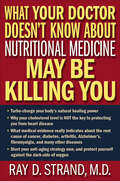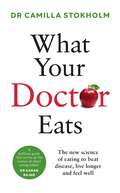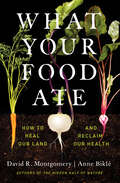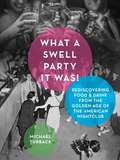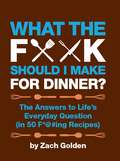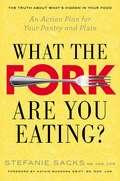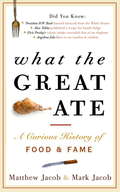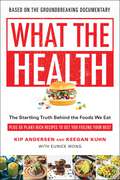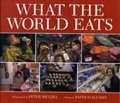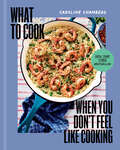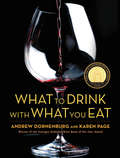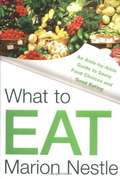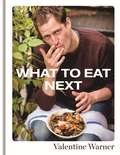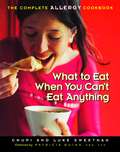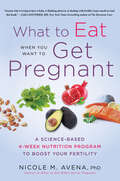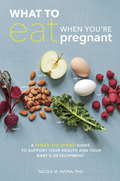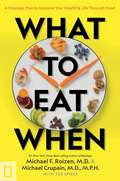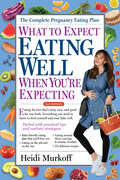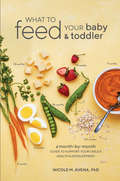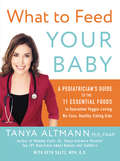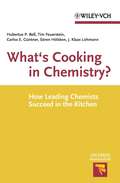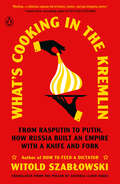- Table View
- List View
What Your Doctor Doesn't Know About Nutritional Medicine May Be Killing You
by Ray D. StrandWhen Dr. Ray Strand found himself in a losing battle, unable to successfully treat his wife who had suffered chronically with pain and fatigue, he agreed to try the regimen of nutritional supplements that a neighbor suggested. Much to his surprise, his wife's condition began to improve almost immediately. That amazing turn of events led him to dedicate himself to researching alternative therapies in medicine, particularly in the arena of nutritional supplements. Dr. Strand's illumination of the body's silent enemy-oxidative stress-will astound you. But, more importantly, his research will equip you to protect or reclaim your nutritional health, possibly reversing disease and preventing illness.
What Your Doctor Eats
by Dr Camilla Stokholm'What Your Doctor Eats is a marvellous fact-filled journey of discovery that everyone can learn from and enjoy.' – Tim SpectorWhen Dr Camilla Stokholm started work as a GP, her health unravelled; she rapidly gained weight, felt exhausted and had debilitating IBS. Determined to find out the root cause, she discovered that what she ate each day played a much bigger role in her well-being than she ever thought possible.What Your Doctor Eats is everything Dr Stokholm has learnt in her journey back to health. Using the tools in this book – including easy ways to boost the gut microbiome, tips to stabilise hormones and hacks to make sustainable change – she transformed her own health and that of her patients, and now you can too.With a mixture of myth-busting facts, a look at the role of our genes and diet culture, along with the latest discoveries in nutrition science and with a delicious recipe section, this book is the only book you need to feel at your very best.
What Your Food Ate: How to Heal Our Land and Reclaim Our Health
by David R. Montgomery Anne BikléAre you really what you eat? David R. Montgomery and Anne Biklé take us far beyond the well-worn adage to deliver a new truth: the roots of good health start on farms. What Your Food Ate marshals evidence from recent and forgotten science to illustrate how the health of the soil ripples through to that of crops, livestock, and ultimately us. The long-running partnerships through which crops and soil life nourish one another suffuse plant and animal foods in the human diet with an array of compounds and nutrients our bodies need to protect us from pathogens and chronic ailments. Unfortunately, conventional agricultural practices unravel these vital partnerships and thereby undercut our well-being. Can farmers and ranchers produce enough nutrient-dense food to feed us all? Can we have quality and quantity? With their trademark thoroughness and knack for integrating information across numerous scientific fields, Montgomery and Biklé chart the way forward. Navigating discoveries and epiphanies about the world beneath our feet, they reveal why regenerative farming practices hold the key to healing sick soil and untapped potential for improving human health. Humanity’s hallmark endeavors of agriculture and medicine emerged from our understanding of the natural world—and still depend on it. Montgomery and Biklé eloquently update this fundamental reality and show us why what’s good for the land is good for us, too. What Your Food Ate is a must-read for farmers, eaters, chefs, doctors, and anyone concerned with reversing the modern epidemic of chronic diseases and mitigating climate change.
What a Swell Party It Was!: Rediscovering Food & Drink from the Golden Age of the American Nightclub
by Michael TurbackChef and restaurateur Daniel Boulud once explained: “The future of cooking is about how we can rewrite the history of it—it’s important to keep the memory and be entertained by it and inspired by it.” What A Swell Party It Was! entertains and inspires with a delicious slice of nearly forgotten culinary history—an era that followed the Great Depression and prohibition’s repeal, where America boomed and the nightclub scene flourished.Opening this book is like swinging open the doors to another time and place, when big city life was a unique mixture of innocence and sophistication, romance and formality. It spotlights twenty-five legendary clubs that thrived in the 1930s and ’40s, just as Jazz exploded into mainstream popularity and alcohol was no longer illegal to serve. Through these pages and recipes, enter past the proverbial velvet rope into establishments forever-immortalized, such as Chez Paree in Chicago, Café Trocadero in Hollywood, The Cocoanut Grove in Los Angeles, The Blue Room in New Orleans, and New York City’s Cotton Club. In addition to including entrée, appetizer, dessert, and cocktail recipes from their original menus, each featured venue will be introduced with vivid anecdotes and history, narrated in a breezy style and illustrated with reproductions of vintage menu covers, beverage napkins, matchbooks, postcards, and rare photos.An unabashedly joyful journey and a deeply authentic perspective on American culture in a rich, tumultuous age, What a Swell Party It Was! promises a cookbook/cocktail guide with a tip of the hat to history, crammed with details that bring life again to a fascinating American era.
What the F*@# Should I Drink?: The Answers to Life's Most Important Question of Your Day (in 75 F*@#ing Recipes) (A What The F* Book)
by Zach Golden75 hilariously profane drinking recipes with unique page prompts and humorous descriptions using easy ingredients and simple directions.
What the F*@# Should I Make for Dinner?: The Answers to Life's Everyday Question (in 50 F*@#ing Recipes) (A What The F* Book)
by Zach GoldenDonOCOt know what to make for dinner? Is every evening an occasion for duress and deliberation? No more "What the F*@# Should I Make For Dinner?" gets everyone off their a**es and in the kitchen. Derived from the incredibly popular website, whatthefuckshouldimakefordinner. com, the book functions like a ?Choose your own adventureOCO cookbook, with options on each page for another f*@#ing idea for dinner. With 50 recipes to choose from, guided by affrontingly creative navigational prompts, both meat-eaters and vegetarians can get cooking and leave their indecisive selves behind. "
What the Fork Are You Eating?
by Kathie Madonna Swift Stefanie SacksIt's labeled "natural," "grass-fed," or "free-roaming;" yet it might be anything but. It's time to find out what you're actually eating... When your groceries are labeled "low-fat," "sugar-free," and even "natural" and "antibiotic-free," it's easy to assume that you're making healthy choices. Yet even some of those seemingly wholesome offerings contain chemical preservatives, pesticides, and artificial flavors and coloring that negatively affect your health. In What the Fork Are You Eating?, a practical guide written by certified chef and nutritionist Stefanie Sacks, MS, CNS, CDN, we learn exactly what the most offensive ingredients in our food are and how we can remove (or at least minimize) them in our diets. Sacks gives us an aisle-by-aisle rundown of how to shop for healthier items and create simple, nutritious, and delicious meals, including fifty original recipes.
What the Great Ate: A Curious History of Food and Fame
by Matthew Jacob Mark JacobFor foodies and trivia lovers alike, this fun and impressively researched pop-culture history offers a sampling of the peculiar culinary habits of the famous--and often notorious--figures throughout the ages.
What the Health: The Startling Truth Behind the Foods We Eat, Plus 50 Plant-Rich Recipes to Get You Feeling Your Best
by Kip Andersen Keegan Kuhn Eunice WongThe definitive, stand-alone companion book to the acclaimed documentary—now with 50 plant-based recipes and full-color photos to help you start changing your health for the better There's something terribly broken in our industrial food, medical, and pharmaceutical systems. What's going wrong? Can we really avoid the leading causes of death just by changing our diet? Kip Andersen and Keegan Kuhn, creators of the revolutionary What the Health and the award-winning Cowspiracy documentaries, take readers on a science-based tour of the hazards posed by consuming animal products—and what happens when we stop. What the Health will guide you on an adventure through this maze of misinformation with the same fresh, engaging approach that made the documentary so popular. Journey with Andersen and Kuhn as they crisscross the country, talking to doctors, dietitians, public health advocates, whistle-blowers, and world-class athletes, to uncover the truth behind the food we eat. With the help of writer Eunice Wong, they empower eaters with knowledge about the lethal entwining of the food, medical, and pharmaceutical industries, and about the corporate web that confuses the public and keeps Americans chronically—and profitably—ill. Plus, discover 50 recipes to help you reclaim your life and health, including: Creamy Mac PB&J Smoothie Winter Lentil and Pomegranate Salad Mom's Ultimate Vegan Chili Black Bean Fudgy Brownies Baked Apple Crumble with Coconut Cream If the film was a peephole, then the book knocks down the whole door, featuring expanded interviews, extensive research, and new personal narratives. There's a health revolution brewing. What the Health is your invitation to join.
What the World Eats
by Faith D'Aluisio Peter Menzel<P>Sitting down to a daily family meal has long been a tradition for billions of people. But in every corner of the world this age-old custom is rapidly changing. From increased trade between countries to the expansion of global food corporations like Kraft and Nestle, current events are having a tremendous impact on our eating habits. Chances are your supermarket is stocking a variety of international foods, and American fast food chains like McDonald's and Kentucky Fried Chicken are popping up all over the planet. For the first time in history, more people are overfed than underfed. And while some people still have barely enough to eat, others overeat to the point of illness. <P> To find out how mealtime is changing in real homes, authors Peter Menzel and Faith D'Aluisio visited families around the world to observe and photograph what they eat during the course of one week. They joined parents while they shopped at mega grocery stores and outdoor markets, and participated in a feast where a single goat was shared among many families. They watched moms making dinner in kitchens and over cooking fires, and they sat down to eat with twenty-five families in twenty-one countries--if you're keeping track, that's about 525 meals! <P>The foods dished up ranged from hunted seal and spit-roasted guinea pig to U. N. -rationed grains and gallons of Coca-Cola. As Peter and Faith ate and talked with families, they learned firsthand about food consumption around the world and its corresponding causes and effects. The resulting family portraits offer a fascinating glimpse into the cultural similarities and differences served on dinner plates around the globe. <P>[This text is listed as an example that meets Common Core Standards in English language arts in grades 2-3 at http://www.corestandards.org.]
What to Cook When You Don't Feel Like Cooking - A Cookbook
by Caroline ChambersTHE INSTANT NEW YORK TIMES, USA TODAY, AND INDIE BESTSELLERA BON APPETIT BEST COOKBOOK OF THE YEAR • A FOOD NETWORK BEST COOKBOOK OF THE YEAR • NATIONAL POST BEST COOKBOOK OF THE YEAR • AN AOL BEST COOKBOOK OF THE YEAR • NAMED ONE OF THE BEST BOOKS TO GIFT BY THE STRATEGIST, TASTING TABLE, AND FORBESRECIPES FOR BUSY PEOPLE WHO LOVE GOOD FOODWith three little boys less than two years apart and a packed schedule as an online creator, Caroline Chambers often doesn&’t feel like cooking. Can you relate? When you just can&’t motivate yourself in the kitchen, this is the simple cookbook you should reach for. Inspired by Caro&’s wildly popular Substack newsletter of the same name, What to Cook When You Don&’t Feel Like Cooking is brimming with efficient recipes that take the guesswork out of dinner—in fact, each one is a complete meal: protein, veg, starch, done! The recipes are organized by the amount of time they take to cook, so whether you have 15 minutes to throw together Peanutty Pork and Brussels or a little bit longer to simmer Turkey Bolognese with Sneaky Veggies, dinnertime is totally doable. On top of that, Caro gives you more ways to choose, so you can search by protein (Chicken thighs waiting in the fridge? Make White Chicken Chili. Nothing but beans in the pantry? Cannellini Caprese with Burrata is it!) or mood (Tomato Farrotto is perfect for a cozy craving, and Crunchy Honey Harissa Fish Tacos are an excellent way to show off). Most importantly, these recipes include Caro&’s famously extensive swaps, riffs, tips, shortcuts, and more to be sure they work best for you, helping you save money, improvise, and even learn a thing or two. They don&’t compromise quality or flavor—and they deliver every time. With as few ingredients, steps, and, of course, dirty dishes as possible, dinner awaits! Perfect for beginners and those seeking easy cookbooks for simple meals, What to Cook When You Don't Feel Like Cooking is the ultimate "I don't want to cook" cookbook. With its focus on efficient, flavorful recipes and minimal ingredients, this easy dinner cookbook appeals to time-constrained parents, working professionals, and anyone who craves delicious homemade meals without the fuss. Readers seeking uncomplicated cookbooks for beginners will appreciate Caroline Chambers' approachable style, clever shortcuts, and flexible recipe options, making this book a go-to resource for satisfying meals on even the most exhausting days.
What to Drink with What You Eat: The Definitive Guide to Pairing Food with Wine, Beer, Spirits, Coffee, Tea -- Even Water -- Based on Expert Advice from America's Best Sommeliers
by Karen Page Andrew DornenburgThe most comprehensive guide to matching food and drink ever compiled, by the James Beard Award winning author team of Karen Page and Andrew Dornenburg, with practical advice from more than seventy of America's leading pairing experts. In a great meal, what you drink is just as important as what you eat. This groundbreaking food and beverage pairing reference allows food lovers to learn to think like a sommelier, and to transform every meal- breakfast, lunch, and dinner - from ordinary to extraordinary. Exceptional in its depth and scope - with over fifteen hundred entries - What to Drink with What You Eat is based on the collective wisdom of experts at dozens of America's best restaurants, including Alinea, Babbo, Bern's, Blue Hill, Chanterelle, Daniel, Emeril's, French Laundry, Frontera Grill, Inn at Little Washington, Jean Georges, Masa's, The Modern, Per Se, Rubicon, Tru, and Valentino. You'll find authoritative recommendations for stocking your cellar and kitchen with must-have beverages, from wines to waters.You'll also learn what to drink with everything from French toast to Chinese food, and what to eat with everything from Pinot Noir to green tea, to create mouthwatering matches. Follow the authors three simple Rules to Remember when making a match - or just dive into the wide-ranging listings in chapters 5 and 6. This incisive, hip writing team (Publisher's Weekly) distills history, geography, science, expert technique, and original insight to create a remarkably user-friendly and engaging reference. Lavishly illustrated with gorgeous four-color photographs, What to Drink with What You Eat is an instant classic essential to every connoisseur's bookshelf.
What to Eat
by Marion NestleHow fresh is fresh? What tastes best? What's the best value? When should I pay more? Is this safe for kids? How should you decide what foods to eat? As supermarkets have grown to warehouse size, this simple question has become complicated beyond belief. Fortunately, Marion Nestle-renowned for her sage advice on food and nutrition- is here to cut through the confusion and lay out what you need to know. In What to Eat, she takes us on a guided tour of the American supermarket and shows us exactly how to feed ourselves and our families wisely and well. With sharp humor, expertise, and a food-lover's delight Nestle guides us through the supermarket sections-product dairy, meat, fish, breads, and juices, and then to the "center aisles," where the big profits are made. Along the way, she reveals the big food companies' marketing practices, explain complex labels in clear language, and tells us what we need to know about: - wild and farm-raised - frozen and fresh - organic, natural, and conventional - carbs, omega-3s, and trans fats - pesticides and the environment - portion size, labeling, and nutrition - supplements, additives, and preservatives The only guide you need today for sensible food shopping and healthy eating, What to Eat is comprehensive, eye-opening, rich in common sense, and a pleasure to read.
What to Eat Next
by Valentine WarnerSome of the best food takes literally only minutes to prepare, and if you have good ingredients, a good recipe and some kitchen know-how the results will be great. The 150 recipes in this book are naturally simple. There is no corner-cutting - just straightforward good cooking. Many of the dishes can be on the table in 30 minutes or less. Others are dishes that, while quick to make, require a slow cook in the oven. Think Pork with Creamy Cider Sauce, Smoked Trout Fish Cakes and Penne Puttanesca - or, for when you have time to leave something in the oven to cook, Cheese, Leek and Potato Pie and Dorset Hot Pot.
What to Eat When You Can't Eat Anything: The Complete Allergy Cookbook
by Chupi Luke SweetmanLiving with food allergies and intolerances used to mean one had to stick to a restrictive, often tasteless, and sometimes downright unpleasant diet?but not anymore. In What to Eat When You CanOCOt Eat Anything, Chupi and Luke Sweetman, who had to rethink the way they ate because of their own food challenges, offer over 120 healthful and delicious dishes that put the joy back into eating. These mouth-watering recipes accompanied by 40 stunning photographs?covering breakfast to dessert?are perfect for all types of food sensitivities, from wheat, sugar, and yeast to dairy products, gluten, and artificial additives, and best of all, they allow readers to indulge in many of the everyday foods that we all know and love. With the collaboration of Patricia Quinn?one of Ireland's best-respected nutritionists?this book is filled with important information and sound advice on specific food allergies and intolerances, what foods and ingredients to stock, how to buy them, and much more. What to Eat When You CanOCOt Eat Anything is guaranteed to add fun?and great taste?to every food-sensitive diet. "
What to Eat When You Want to Get Pregnant: A Science-Based 4-Week Nutrition Program to Boost Your Fertility
by Nicole AvenaTrying to get pregnant? You&’ll want this book in your arsenal! Joining the ranks with pregnancy experts such as Heidi Murkoff, Dr. Avena is back and here to help. Making a healthy baby begins with healthy ingredients. Learn how to hack your diet to increase fertility—getting your body into the best baby-making shape—in only four weeks! The latest research reveals that by optimizing nutrition, you can boost your chances of conceiving and having a safe, healthy pregnancy and baby. But with so much information out there, how can you make sure you&’re getting the nutrients you need to maximize fertility and avoiding the seemingly healthy foods that could be interfering with fertility? In this comprehensive guide, diet and nutrition expert and research neuroscientist Dr. Nicole Avena offers revolutionary science-based advice for women and men who are either thinking about having a baby, already trying, or dealing with fertility issues. Dr. Avena pares down the research so that you can apply the new science to your real life, including valuable information such as: *What nutrients are specifically tied to fertility and pregnancy, how much of each you need, why you need it, and which food sources are best *Which plant-based protein sources promote pregnancy without disrupting hormone levels *Why men&’s fertility is just as important as women&’s, and which foods can increase sperm motility and health *How to add pregnancy-friendly fats to your diet *The truth about the link between body weight and fertility . . . and much more, including a 4-week plan to get you started on the path to parenthood. A psychologist and mother herself, Dr. Avena also offers practical advice, as well as 40 delicious, simple recipes that you can easily incorporate into your lifestyle to create the best environment for your baby-to-be—one that will positively impact the whole family, all while feeling better than you&’ve ever felt.
What to Eat When You're Pregnant
by Dr Nicole M. AvenaA trimester-by-trimester guide to what to eat--as opposed to what to avoid--while pregnant and nursing, to support the mother's health and the baby's development during each stage of pregnancy, with 50 recipes. Pregnancy has traditionally been viewed as a time when women can give in to their food cravings and not worry about their weight. But new research suggests that the foods women eat during pregnancy can have a lasting effect on the baby's brain development and behavior, as well as the mother's waistline. While many books tell women what not to eat, there are few guides that tell women what to eat while also considering that hormonal influences during pregnancy can make it difficult to stick to a healthy diet. More and more women enter pregnancy overweight, gain an unhealthy amount of weight while pregnant, then struggle to lose the "baby weight" after the baby is born. Drawing on the latest research from the fields of medicine, nutrition, and psychology, this guide gives moms-to-be a clear understanding of what their bodies really need and how those foods contribute to the development of healthy and happy babies.
What to Eat When: A Strategic Plan to Improve Your Health and Life Through Food
by Ted Spiker Michael Roizen Michael CrupainNY Times best-selling author Dr. Michael Roizen reveals how the food choices you make each day--and when you make them--can affect your health, your energy, your sex life, your waistline, your attitude, and the way you age.What if eating two cups of blueberries a day could prevent cancer? If drinking a kale-infused smoothie could counteract missing an hour's worth of sleep? When is the right time of day to eat that chocolate chip cookie? And would you actually drink that glass of water if it meant skipping the gym? This revolutionary guide reveals how to use food to enhance our personal and professional lives--and increase longevity to boot. What to Eat When is not a diet book. Instead, acclaimed internist Michael Roizen and preventive medicine specialist Michael Crupain offer readers choices that benefit them the most--whether it's meals to help them look and feel younger or snacks that prevent diseases--based on the science that governs them.
What to Eat for a Long & Healthy Life
by The Editors at the University of California at Berkeley5 chapters: Diet for a Healthy Heart, Diet to Lower Blood Pressure, Diet and Cancer Prevention, The Right Diet for Diabetes, and Nutrition for Strong Bones. Includes 12 recipes.
What to Expect When You Have Diabetes: 170 Tips for Living Well with Diabetes (Revised & Updated)
by American Diabetes Association John BuseManaging a chronic disease like diabetes can be overwhelming-especially if you’re among the 1.7 million Americans who are newly diagnosed each year. Here is easy-to-read, steady advice in this newly updated book, written by the experts, so you can live well with diabetes, not just manage it. What to Expect When You Have Diabetes is a reliable companion for when you’re swamped with questions but also have more information than you can absorb.The information in this book is geared especially toward people with type 2 diabetes, primarily because 90-95 percent of those with diabetes have type 2. Type 1 is more rare, but most of the treatment and lifestyle suggestions given here are helpful for both.A Q&A format, organized by topic for quick reference, provides authoritative but understandable answers to a range of questions, such as: Is diabetes a dangerous disease? Should I tell my supervisor and coworkers that I have diabetes? Will the medication I’m taking for depression affect my blood sugar?This book is a perfect companion to a health-care team and is sure to become a trusted reference as you live with diabetes.
What to Expect: Eating Well When You're Expecting (What to Expect)
by Heidi MurkoffEat well––for two! &“Once again, What to Expect Delivers! Heidi&’s go-to guide takes the guesswork out of feeding yourself and your baby, serving up a healthy and realistic plan to fit every lifestyle and eating style. It&’s eating for two made easy, fun… and delicious.&”––Joy Bauer, MS, RD, CDN, best-selling author, host of NBC&’S Health and Happiness, and nutrition expert for the Today show This brand new edition of America&’s pregnancy food bible covers it all through those nine months of baby-making and beyond: the latest facts on superfoods, food trends, food safety. Foods to chow down on, foods (and drinks) to limit, and those to cut out altogether. Realistic, body-positive advice and savvy strategies on how to eat well when you&’re too green to come face-to-fork with broccoli. Or too bloated to eat at all. Or on the run. Or on the job. Whether you&’re a red-meat eater or a vegan, a carb craver or a gluten-free girl, a fast-foodie or a slow cooker. Whether you&’re hungry for nutritional facts (which vitamins and minerals the pregnant body needs and where to find them), or just plain hungry. Plus, how to put it all together, easily and tastily, with dozens of practical tips and 170 recipes that are as delicious as they are nutritious, as easy to love as they are to make. Answers to all questions:Do I have to skip my morning latte––or afternoon energy drink?I&’m too sick to look at a salad, never mind eat one––do I have to?How do I get enough calcium if I&’m lactose intolerant?Help! I&’m entering my second trimester, and I&’m losing weight, not gaining. What can I do?I&’ve never been a big water drinker, and now I&’m supposed to down 10 8-ounce glasses a day! How?Turns out it&’s twins––do I have to eat twice as much?
What to Feed Your Baby and Toddler: A Month-by-Month Guide to Support Your Child's Health and Development
by Nicole M. AvenaA science-based manual for feeding babies exactly what they need to hit physical and intellectual milestones from 6 to 24 months, with 60 recipes.World-renowned research neuroscientist, nutrition expert, and author of What to Eat When You're Pregnant Dr. Nicole M. Avena presents an essential guide for new parents on feeding babies during their critical first two years. Answering common questions about picky eaters, food allergies, diversifying baby's appetite, eating out or on the go, feeding baby at daycare or when with another caregiver, and food safety, this comprehensive guide offers easy monthly meal plans and baby-friendly, nutrient-rich recipes designed to support your baby's developmental milestones.
What to Feed Your Baby: A Pediatrician's Guide to the Eleven Essential Foods to Guarantee Veggie-Loving, No-Fuss, Healthy-Eating Kids
by Tanya Altmann Beth SaltzAs a pediatrician, spokesperson for the American Academy of Pediatrics, and mother of three boys, Dr. Tanya Altmann knows that good nutrition is essential for healthy kids. In What to Feed Your Baby, Dr. Tanya provides the latest nutritional recommendations and best practices for feeding babies and young children. The simple, fool-proof program focuses on serving eleven foundation foods: eggs, prunes, avocado, fish, yogurt/cheese/milk, nuts, chicken/beans, fruit, green veggies, whole grains, and water. What to Feed Your Baby helps parents set their children up for a lifetime of healthy choices—and say goodbye to picky eating forever!
What's Cooking in Chemistry?: How Leading Chemists Succeed in the Kitchen (Erlebnis Wissenschaft #5)
by Carlos E. Güntner Tim Feuerstein Hubertus P. Bell Sören Hölsken J. Klaas LohmannLooking for future employment as a postdoc? Or desperately looking for the perfect present for a chemist friend? Maybe you simply enjoy cooking and reading about current developments in chemistry research? The first Who's Who in organic chemistry to show what top scientists like to cook - on the bench and on the stove - and how they have made their way. Use K. C. Nicolaou's recipe for fish and chips and read about his scientific work while preparing the meal that helped him finance his studies back in England. Containing more than 50 personal recipes and anecdotes from leading organic chemists, such as Lonely soup (Evans), Wild boar - Tuscan way (Waldmann), and Dulce de Leche (Vollhardt), accompanied by biographies and sketches of their current work, this is an exquisite delicacy for anybody who likes cooking, eating and chemistry.
What's Cooking in the Kremlin: From Rasputin to Putin, How Russia Built an Empire with a Knife and Fork
by Witold Szablowski&“Chatty and illuminating.&” —The New York Times&“Riveting—a delicious odyssey full of history, humor, and jaw-dropping stories. If you want to understand the making of modern Russia, read this book.&” —Daniel Stone, bestselling author of The Food ExplorerA high-spirited, eye-opening, appetite-whetting culinary travel adventure that tells the story of the last hundred years of Russian power through food, by an award-winning Polish journalist who&’s been praised by both Timothy Snyder and Bill BufordIn the gonzo spirit of Anthony Bourdain and Hunter S. Thompson, Witold Szabłowski has tracked down—and broken bread with—people whose stories of working in Kremlin kitchens impart a surprising flavor to our understanding of one of the world&’s superpowers.In revealing what Tsar Nicholas II&’s and Lenin&’s favorite meals were, why Stalin&’s cook taught Gorbachev&’s cook to sing to his dough, how Stalin had a food tester while he was starving the Ukrainians during the Great Famine, what the recipe was for the first soup flown into outer space, why Brezhnev hated caviar, what was served to the Soviet Union&’s leaders at the very moment they decided the USSR should cease to exist, and whether Putin&’s grandfather really did cook for Lenin and Stalin, Szabłowski has written a fascinating oral history—complete with recipes and photos—of Russia&’s evolution from culinary indifference to decadence, famine to feasts, and of the Kremlin&’s Olympics-style preoccupation with food as an expression of the country&’s global standing.Traveling across Stalin&’s Georgia, the war fronts of Afghanistan, the nuclear wastelands of Chornobyl, and even to a besieged steelworks plant in Mariupol—often with one-of-a-kind access to locales forbidden to foreign eyes, and with a rousing sense of adventure and an inimitable ability to get people to spill the tea—he shows that a century after the revolution, Russia still uses food as an instrument of war and feeds its people on propaganda.
